Encouraging Smart Home Technology Adoption: A Consumer Insight Report
VerifiedAdded on 2023/03/30
|8
|2238
|406
Report
AI Summary
This report examines consumer behavior related to the adoption of smart home technology, focusing on the affluent, sustainability-conscious segment of the Australian population. It reviews the advantages and disadvantages of smart home technology, including energy savings, convenience, and potential security risks. The report applies the theory of planned behavior to understand consumer intentions and proposes marketing strategies that harmonize security, privacy, and functionality. These strategies include building devices with instant information deletion, utilizing microphone setups, providing detailed instruction manuals, and centralizing smart home experiences through digital dashboards. The report concludes with recommendations for companies to innovate and provide better information to encourage smart home technology adoption.
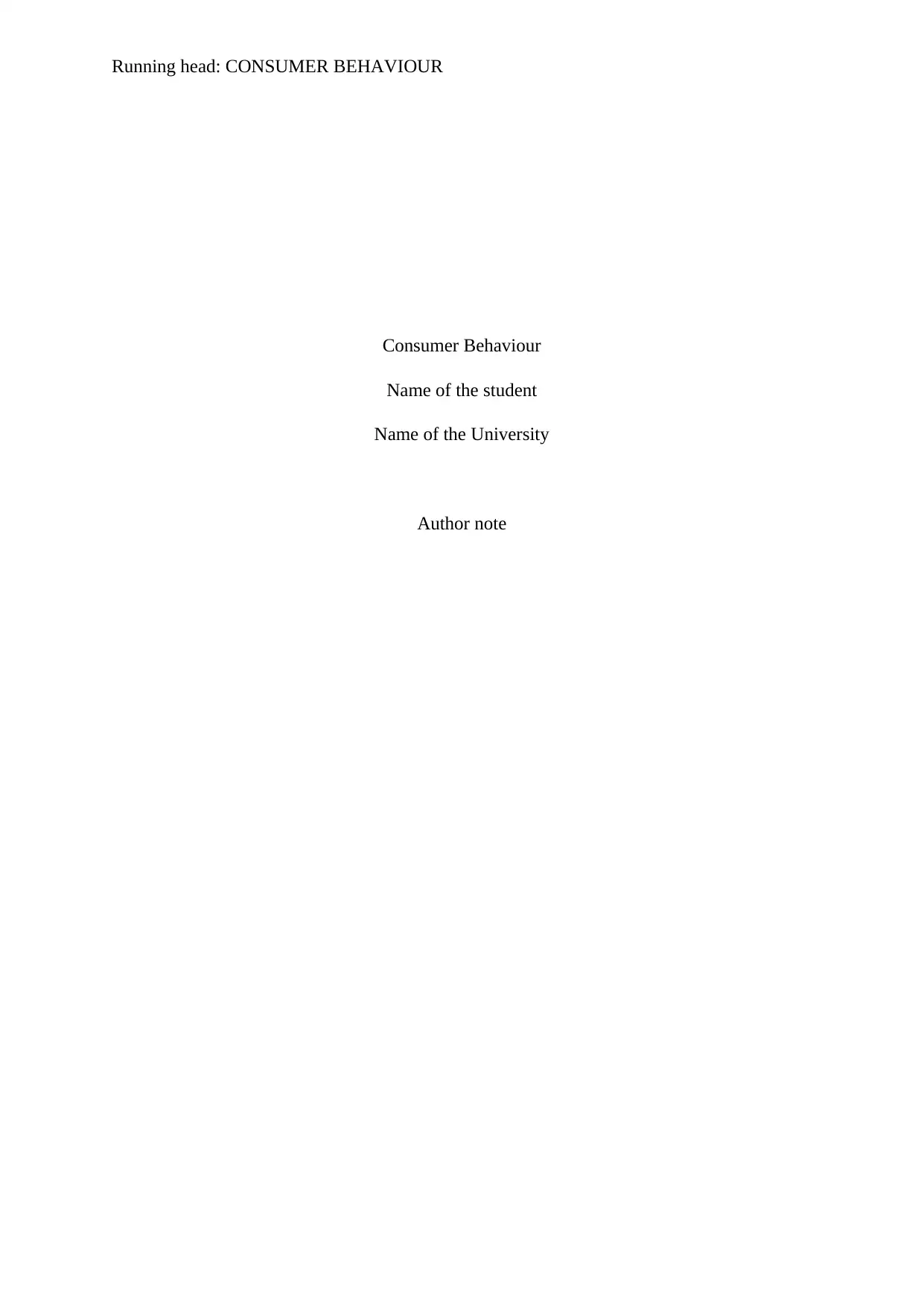
Running head: CONSUMER BEHAVIOUR
Consumer Behaviour
Name of the student
Name of the University
Author note
Consumer Behaviour
Name of the student
Name of the University
Author note
Paraphrase This Document
Need a fresh take? Get an instant paraphrase of this document with our AI Paraphraser
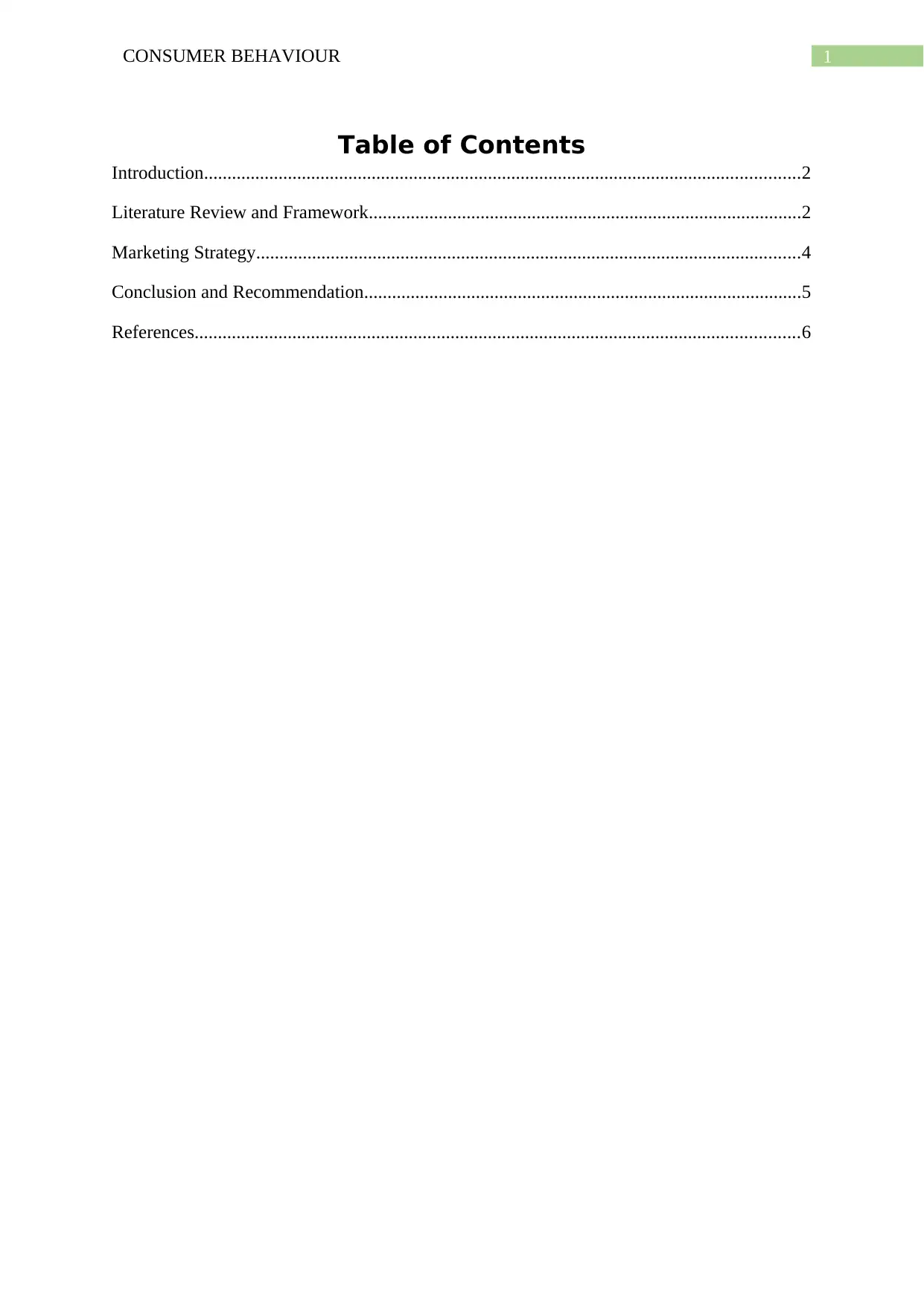
1CONSUMER BEHAVIOUR
Table of Contents
Introduction................................................................................................................................2
Literature Review and Framework.............................................................................................2
Marketing Strategy.....................................................................................................................4
Conclusion and Recommendation..............................................................................................5
References..................................................................................................................................6
Table of Contents
Introduction................................................................................................................................2
Literature Review and Framework.............................................................................................2
Marketing Strategy.....................................................................................................................4
Conclusion and Recommendation..............................................................................................5
References..................................................................................................................................6
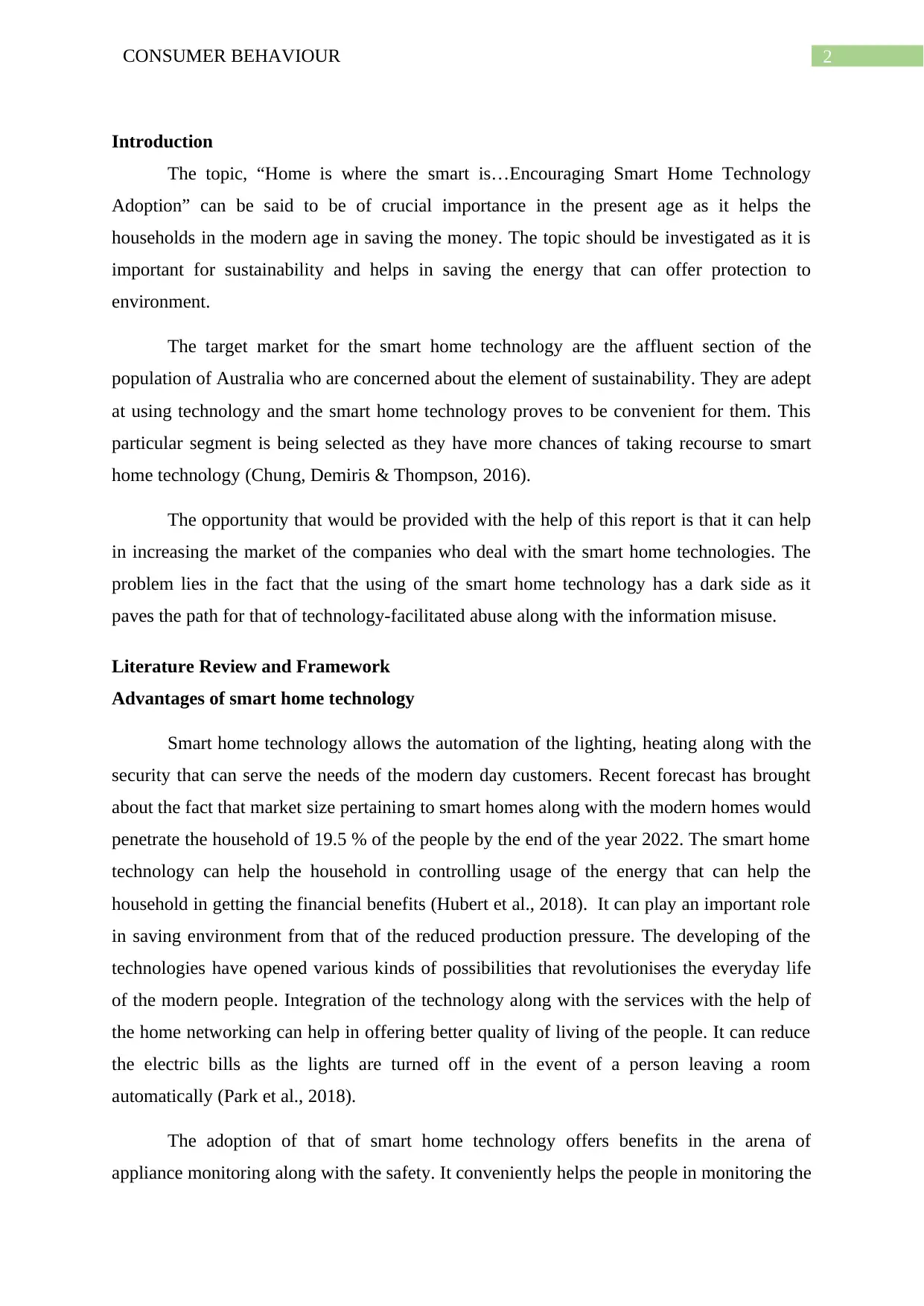
2CONSUMER BEHAVIOUR
Introduction
The topic, “Home is where the smart is…Encouraging Smart Home Technology
Adoption” can be said to be of crucial importance in the present age as it helps the
households in the modern age in saving the money. The topic should be investigated as it is
important for sustainability and helps in saving the energy that can offer protection to
environment.
The target market for the smart home technology are the affluent section of the
population of Australia who are concerned about the element of sustainability. They are adept
at using technology and the smart home technology proves to be convenient for them. This
particular segment is being selected as they have more chances of taking recourse to smart
home technology (Chung, Demiris & Thompson, 2016).
The opportunity that would be provided with the help of this report is that it can help
in increasing the market of the companies who deal with the smart home technologies. The
problem lies in the fact that the using of the smart home technology has a dark side as it
paves the path for that of technology-facilitated abuse along with the information misuse.
Literature Review and Framework
Advantages of smart home technology
Smart home technology allows the automation of the lighting, heating along with the
security that can serve the needs of the modern day customers. Recent forecast has brought
about the fact that market size pertaining to smart homes along with the modern homes would
penetrate the household of 19.5 % of the people by the end of the year 2022. The smart home
technology can help the household in controlling usage of the energy that can help the
household in getting the financial benefits (Hubert et al., 2018). It can play an important role
in saving environment from that of the reduced production pressure. The developing of the
technologies have opened various kinds of possibilities that revolutionises the everyday life
of the modern people. Integration of the technology along with the services with the help of
the home networking can help in offering better quality of living of the people. It can reduce
the electric bills as the lights are turned off in the event of a person leaving a room
automatically (Park et al., 2018).
The adoption of that of smart home technology offers benefits in the arena of
appliance monitoring along with the safety. It conveniently helps the people in monitoring the
Introduction
The topic, “Home is where the smart is…Encouraging Smart Home Technology
Adoption” can be said to be of crucial importance in the present age as it helps the
households in the modern age in saving the money. The topic should be investigated as it is
important for sustainability and helps in saving the energy that can offer protection to
environment.
The target market for the smart home technology are the affluent section of the
population of Australia who are concerned about the element of sustainability. They are adept
at using technology and the smart home technology proves to be convenient for them. This
particular segment is being selected as they have more chances of taking recourse to smart
home technology (Chung, Demiris & Thompson, 2016).
The opportunity that would be provided with the help of this report is that it can help
in increasing the market of the companies who deal with the smart home technologies. The
problem lies in the fact that the using of the smart home technology has a dark side as it
paves the path for that of technology-facilitated abuse along with the information misuse.
Literature Review and Framework
Advantages of smart home technology
Smart home technology allows the automation of the lighting, heating along with the
security that can serve the needs of the modern day customers. Recent forecast has brought
about the fact that market size pertaining to smart homes along with the modern homes would
penetrate the household of 19.5 % of the people by the end of the year 2022. The smart home
technology can help the household in controlling usage of the energy that can help the
household in getting the financial benefits (Hubert et al., 2018). It can play an important role
in saving environment from that of the reduced production pressure. The developing of the
technologies have opened various kinds of possibilities that revolutionises the everyday life
of the modern people. Integration of the technology along with the services with the help of
the home networking can help in offering better quality of living of the people. It can reduce
the electric bills as the lights are turned off in the event of a person leaving a room
automatically (Park et al., 2018).
The adoption of that of smart home technology offers benefits in the arena of
appliance monitoring along with the safety. It conveniently helps the people in monitoring the
⊘ This is a preview!⊘
Do you want full access?
Subscribe today to unlock all pages.

Trusted by 1+ million students worldwide
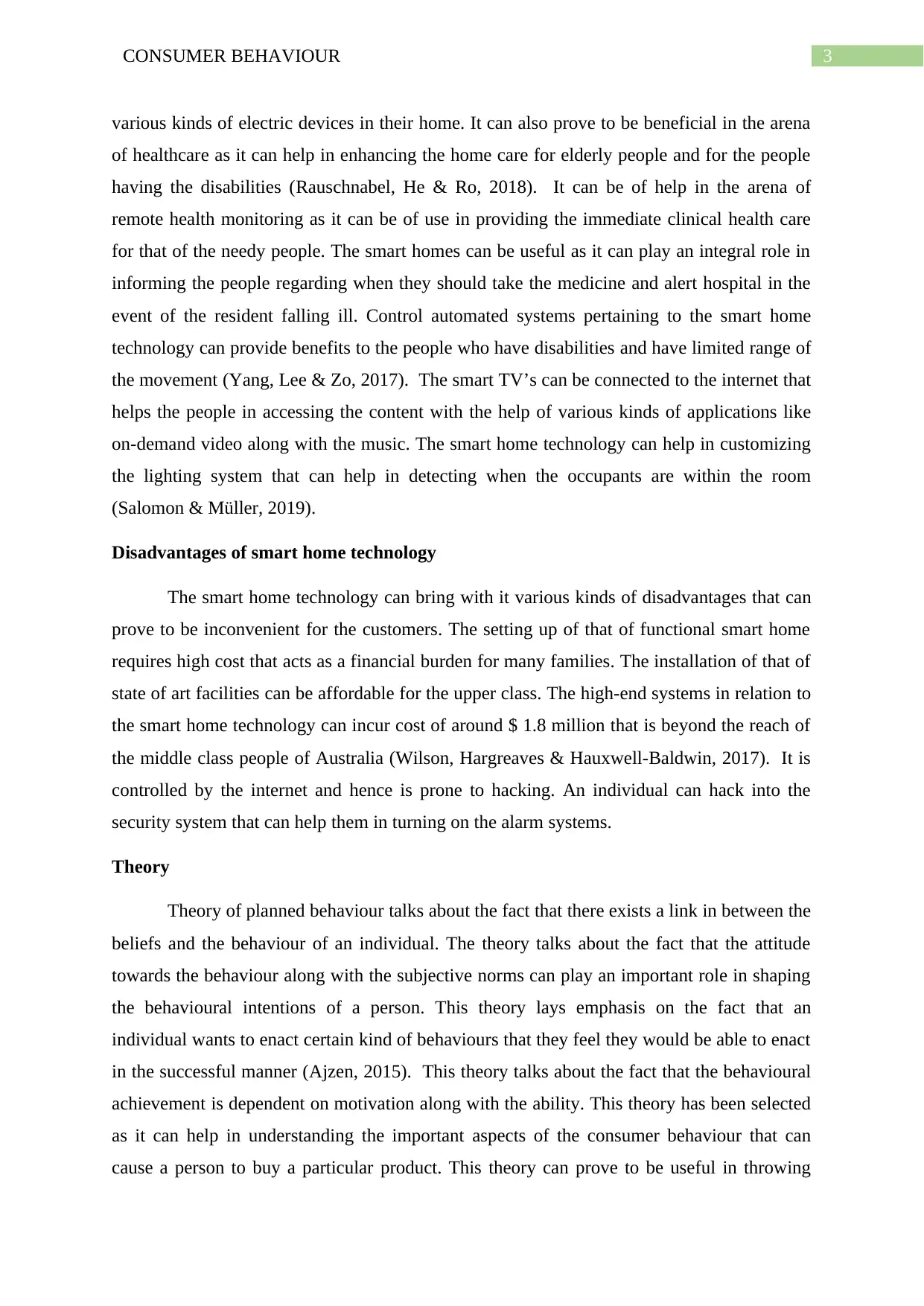
3CONSUMER BEHAVIOUR
various kinds of electric devices in their home. It can also prove to be beneficial in the arena
of healthcare as it can help in enhancing the home care for elderly people and for the people
having the disabilities (Rauschnabel, He & Ro, 2018). It can be of help in the arena of
remote health monitoring as it can be of use in providing the immediate clinical health care
for that of the needy people. The smart homes can be useful as it can play an integral role in
informing the people regarding when they should take the medicine and alert hospital in the
event of the resident falling ill. Control automated systems pertaining to the smart home
technology can provide benefits to the people who have disabilities and have limited range of
the movement (Yang, Lee & Zo, 2017). The smart TV’s can be connected to the internet that
helps the people in accessing the content with the help of various kinds of applications like
on-demand video along with the music. The smart home technology can help in customizing
the lighting system that can help in detecting when the occupants are within the room
(Salomon & Müller, 2019).
Disadvantages of smart home technology
The smart home technology can bring with it various kinds of disadvantages that can
prove to be inconvenient for the customers. The setting up of that of functional smart home
requires high cost that acts as a financial burden for many families. The installation of that of
state of art facilities can be affordable for the upper class. The high-end systems in relation to
the smart home technology can incur cost of around $ 1.8 million that is beyond the reach of
the middle class people of Australia (Wilson, Hargreaves & Hauxwell-Baldwin, 2017). It is
controlled by the internet and hence is prone to hacking. An individual can hack into the
security system that can help them in turning on the alarm systems.
Theory
Theory of planned behaviour talks about the fact that there exists a link in between the
beliefs and the behaviour of an individual. The theory talks about the fact that the attitude
towards the behaviour along with the subjective norms can play an important role in shaping
the behavioural intentions of a person. This theory lays emphasis on the fact that an
individual wants to enact certain kind of behaviours that they feel they would be able to enact
in the successful manner (Ajzen, 2015). This theory talks about the fact that the behavioural
achievement is dependent on motivation along with the ability. This theory has been selected
as it can help in understanding the important aspects of the consumer behaviour that can
cause a person to buy a particular product. This theory can prove to be useful in throwing
various kinds of electric devices in their home. It can also prove to be beneficial in the arena
of healthcare as it can help in enhancing the home care for elderly people and for the people
having the disabilities (Rauschnabel, He & Ro, 2018). It can be of help in the arena of
remote health monitoring as it can be of use in providing the immediate clinical health care
for that of the needy people. The smart homes can be useful as it can play an integral role in
informing the people regarding when they should take the medicine and alert hospital in the
event of the resident falling ill. Control automated systems pertaining to the smart home
technology can provide benefits to the people who have disabilities and have limited range of
the movement (Yang, Lee & Zo, 2017). The smart TV’s can be connected to the internet that
helps the people in accessing the content with the help of various kinds of applications like
on-demand video along with the music. The smart home technology can help in customizing
the lighting system that can help in detecting when the occupants are within the room
(Salomon & Müller, 2019).
Disadvantages of smart home technology
The smart home technology can bring with it various kinds of disadvantages that can
prove to be inconvenient for the customers. The setting up of that of functional smart home
requires high cost that acts as a financial burden for many families. The installation of that of
state of art facilities can be affordable for the upper class. The high-end systems in relation to
the smart home technology can incur cost of around $ 1.8 million that is beyond the reach of
the middle class people of Australia (Wilson, Hargreaves & Hauxwell-Baldwin, 2017). It is
controlled by the internet and hence is prone to hacking. An individual can hack into the
security system that can help them in turning on the alarm systems.
Theory
Theory of planned behaviour talks about the fact that there exists a link in between the
beliefs and the behaviour of an individual. The theory talks about the fact that the attitude
towards the behaviour along with the subjective norms can play an important role in shaping
the behavioural intentions of a person. This theory lays emphasis on the fact that an
individual wants to enact certain kind of behaviours that they feel they would be able to enact
in the successful manner (Ajzen, 2015). This theory talks about the fact that the behavioural
achievement is dependent on motivation along with the ability. This theory has been selected
as it can help in understanding the important aspects of the consumer behaviour that can
cause a person to buy a particular product. This theory can prove to be useful in throwing
Paraphrase This Document
Need a fresh take? Get an instant paraphrase of this document with our AI Paraphraser
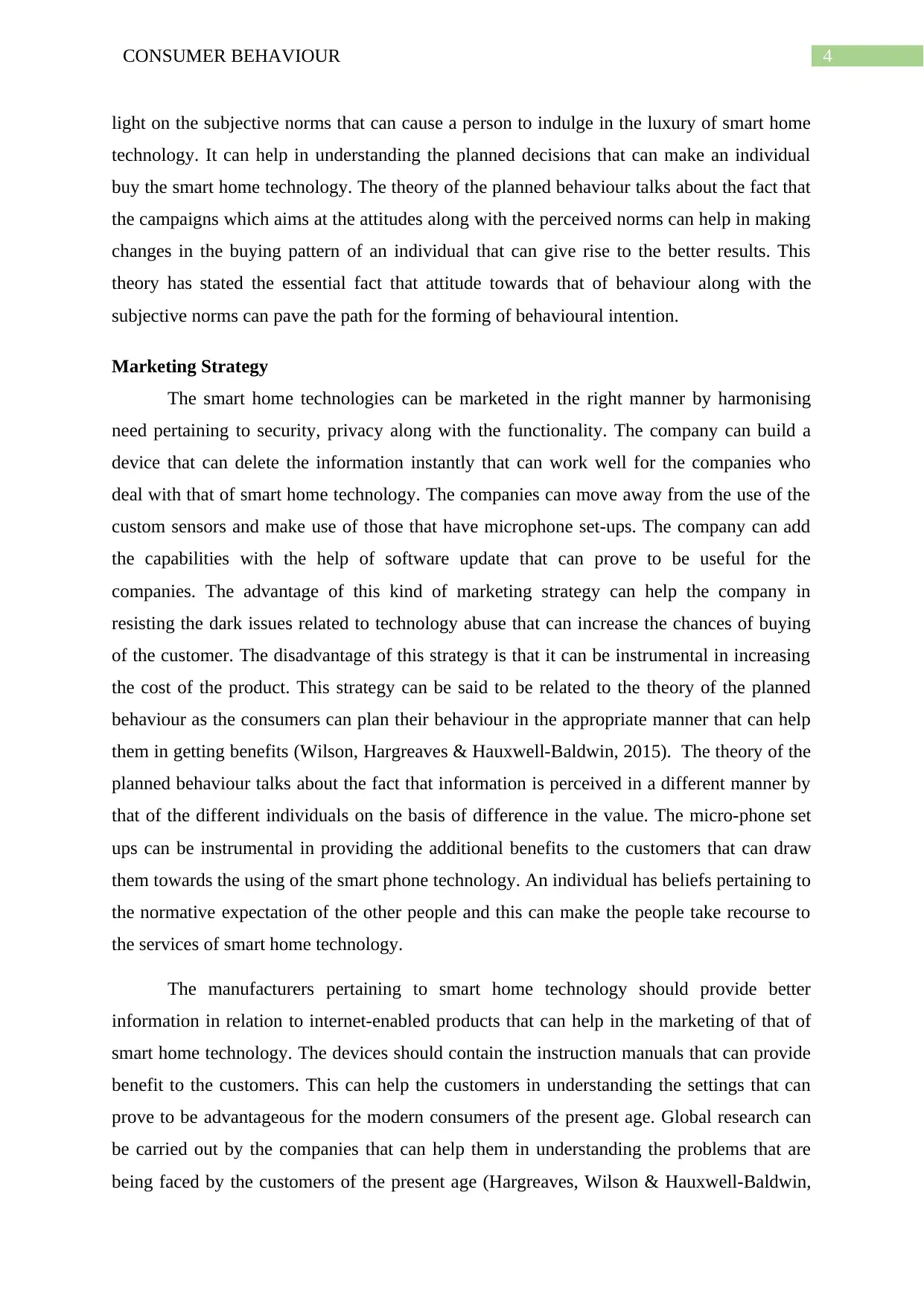
4CONSUMER BEHAVIOUR
light on the subjective norms that can cause a person to indulge in the luxury of smart home
technology. It can help in understanding the planned decisions that can make an individual
buy the smart home technology. The theory of the planned behaviour talks about the fact that
the campaigns which aims at the attitudes along with the perceived norms can help in making
changes in the buying pattern of an individual that can give rise to the better results. This
theory has stated the essential fact that attitude towards that of behaviour along with the
subjective norms can pave the path for the forming of behavioural intention.
Marketing Strategy
The smart home technologies can be marketed in the right manner by harmonising
need pertaining to security, privacy along with the functionality. The company can build a
device that can delete the information instantly that can work well for the companies who
deal with that of smart home technology. The companies can move away from the use of the
custom sensors and make use of those that have microphone set-ups. The company can add
the capabilities with the help of software update that can prove to be useful for the
companies. The advantage of this kind of marketing strategy can help the company in
resisting the dark issues related to technology abuse that can increase the chances of buying
of the customer. The disadvantage of this strategy is that it can be instrumental in increasing
the cost of the product. This strategy can be said to be related to the theory of the planned
behaviour as the consumers can plan their behaviour in the appropriate manner that can help
them in getting benefits (Wilson, Hargreaves & Hauxwell-Baldwin, 2015). The theory of the
planned behaviour talks about the fact that information is perceived in a different manner by
that of the different individuals on the basis of difference in the value. The micro-phone set
ups can be instrumental in providing the additional benefits to the customers that can draw
them towards the using of the smart phone technology. An individual has beliefs pertaining to
the normative expectation of the other people and this can make the people take recourse to
the services of smart home technology.
The manufacturers pertaining to smart home technology should provide better
information in relation to internet-enabled products that can help in the marketing of that of
smart home technology. The devices should contain the instruction manuals that can provide
benefit to the customers. This can help the customers in understanding the settings that can
prove to be advantageous for the modern consumers of the present age. Global research can
be carried out by the companies that can help them in understanding the problems that are
being faced by the customers of the present age (Hargreaves, Wilson & Hauxwell-Baldwin,
light on the subjective norms that can cause a person to indulge in the luxury of smart home
technology. It can help in understanding the planned decisions that can make an individual
buy the smart home technology. The theory of the planned behaviour talks about the fact that
the campaigns which aims at the attitudes along with the perceived norms can help in making
changes in the buying pattern of an individual that can give rise to the better results. This
theory has stated the essential fact that attitude towards that of behaviour along with the
subjective norms can pave the path for the forming of behavioural intention.
Marketing Strategy
The smart home technologies can be marketed in the right manner by harmonising
need pertaining to security, privacy along with the functionality. The company can build a
device that can delete the information instantly that can work well for the companies who
deal with that of smart home technology. The companies can move away from the use of the
custom sensors and make use of those that have microphone set-ups. The company can add
the capabilities with the help of software update that can prove to be useful for the
companies. The advantage of this kind of marketing strategy can help the company in
resisting the dark issues related to technology abuse that can increase the chances of buying
of the customer. The disadvantage of this strategy is that it can be instrumental in increasing
the cost of the product. This strategy can be said to be related to the theory of the planned
behaviour as the consumers can plan their behaviour in the appropriate manner that can help
them in getting benefits (Wilson, Hargreaves & Hauxwell-Baldwin, 2015). The theory of the
planned behaviour talks about the fact that information is perceived in a different manner by
that of the different individuals on the basis of difference in the value. The micro-phone set
ups can be instrumental in providing the additional benefits to the customers that can draw
them towards the using of the smart phone technology. An individual has beliefs pertaining to
the normative expectation of the other people and this can make the people take recourse to
the services of smart home technology.
The manufacturers pertaining to smart home technology should provide better
information in relation to internet-enabled products that can help in the marketing of that of
smart home technology. The devices should contain the instruction manuals that can provide
benefit to the customers. This can help the customers in understanding the settings that can
prove to be advantageous for the modern consumers of the present age. Global research can
be carried out by the companies that can help them in understanding the problems that are
being faced by the customers of the present age (Hargreaves, Wilson & Hauxwell-Baldwin,
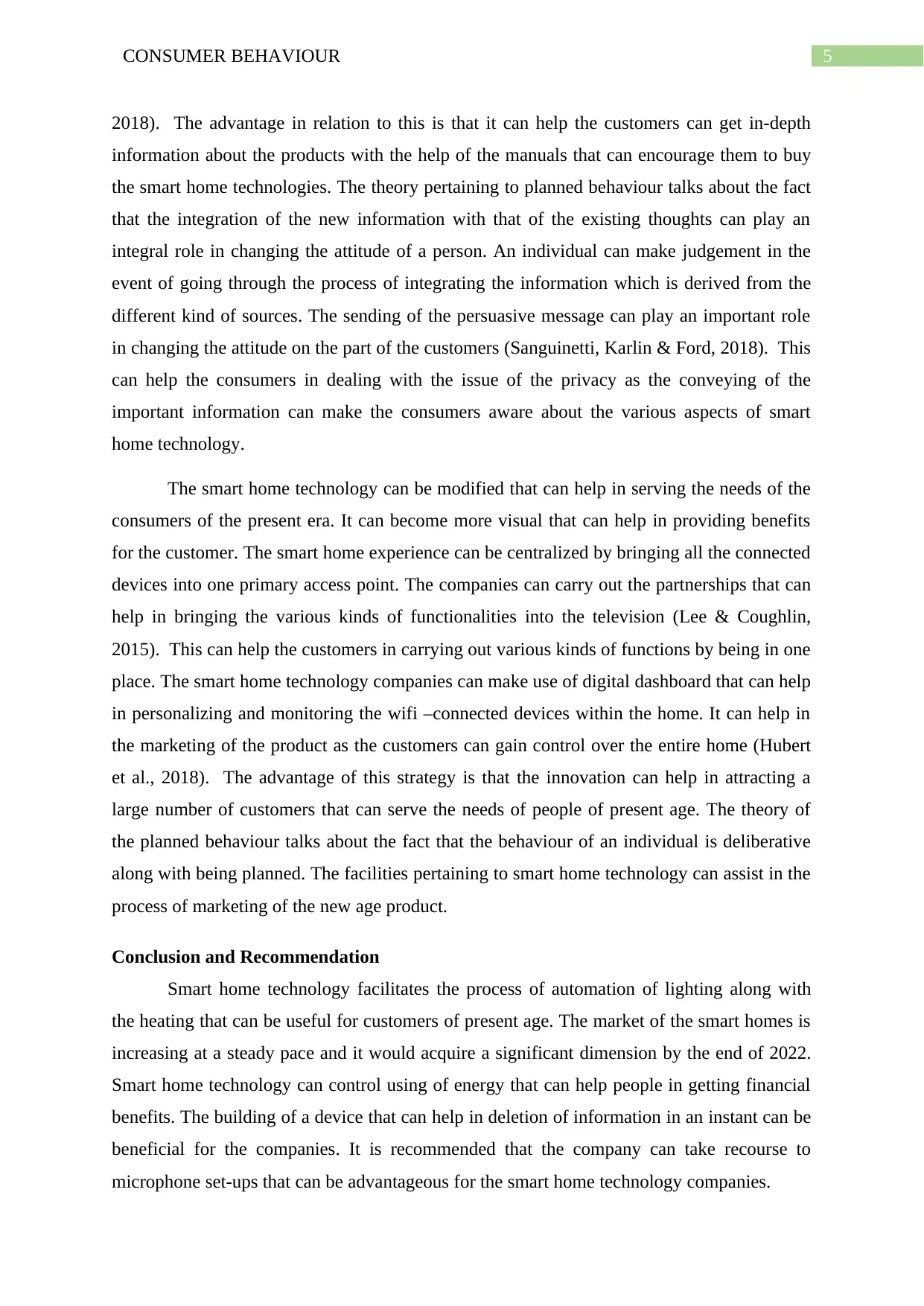
5CONSUMER BEHAVIOUR
2018). The advantage in relation to this is that it can help the customers can get in-depth
information about the products with the help of the manuals that can encourage them to buy
the smart home technologies. The theory pertaining to planned behaviour talks about the fact
that the integration of the new information with that of the existing thoughts can play an
integral role in changing the attitude of a person. An individual can make judgement in the
event of going through the process of integrating the information which is derived from the
different kind of sources. The sending of the persuasive message can play an important role
in changing the attitude on the part of the customers (Sanguinetti, Karlin & Ford, 2018). This
can help the consumers in dealing with the issue of the privacy as the conveying of the
important information can make the consumers aware about the various aspects of smart
home technology.
The smart home technology can be modified that can help in serving the needs of the
consumers of the present era. It can become more visual that can help in providing benefits
for the customer. The smart home experience can be centralized by bringing all the connected
devices into one primary access point. The companies can carry out the partnerships that can
help in bringing the various kinds of functionalities into the television (Lee & Coughlin,
2015). This can help the customers in carrying out various kinds of functions by being in one
place. The smart home technology companies can make use of digital dashboard that can help
in personalizing and monitoring the wifi –connected devices within the home. It can help in
the marketing of the product as the customers can gain control over the entire home (Hubert
et al., 2018). The advantage of this strategy is that the innovation can help in attracting a
large number of customers that can serve the needs of people of present age. The theory of
the planned behaviour talks about the fact that the behaviour of an individual is deliberative
along with being planned. The facilities pertaining to smart home technology can assist in the
process of marketing of the new age product.
Conclusion and Recommendation
Smart home technology facilitates the process of automation of lighting along with
the heating that can be useful for customers of present age. The market of the smart homes is
increasing at a steady pace and it would acquire a significant dimension by the end of 2022.
Smart home technology can control using of energy that can help people in getting financial
benefits. The building of a device that can help in deletion of information in an instant can be
beneficial for the companies. It is recommended that the company can take recourse to
microphone set-ups that can be advantageous for the smart home technology companies.
2018). The advantage in relation to this is that it can help the customers can get in-depth
information about the products with the help of the manuals that can encourage them to buy
the smart home technologies. The theory pertaining to planned behaviour talks about the fact
that the integration of the new information with that of the existing thoughts can play an
integral role in changing the attitude of a person. An individual can make judgement in the
event of going through the process of integrating the information which is derived from the
different kind of sources. The sending of the persuasive message can play an important role
in changing the attitude on the part of the customers (Sanguinetti, Karlin & Ford, 2018). This
can help the consumers in dealing with the issue of the privacy as the conveying of the
important information can make the consumers aware about the various aspects of smart
home technology.
The smart home technology can be modified that can help in serving the needs of the
consumers of the present era. It can become more visual that can help in providing benefits
for the customer. The smart home experience can be centralized by bringing all the connected
devices into one primary access point. The companies can carry out the partnerships that can
help in bringing the various kinds of functionalities into the television (Lee & Coughlin,
2015). This can help the customers in carrying out various kinds of functions by being in one
place. The smart home technology companies can make use of digital dashboard that can help
in personalizing and monitoring the wifi –connected devices within the home. It can help in
the marketing of the product as the customers can gain control over the entire home (Hubert
et al., 2018). The advantage of this strategy is that the innovation can help in attracting a
large number of customers that can serve the needs of people of present age. The theory of
the planned behaviour talks about the fact that the behaviour of an individual is deliberative
along with being planned. The facilities pertaining to smart home technology can assist in the
process of marketing of the new age product.
Conclusion and Recommendation
Smart home technology facilitates the process of automation of lighting along with
the heating that can be useful for customers of present age. The market of the smart homes is
increasing at a steady pace and it would acquire a significant dimension by the end of 2022.
Smart home technology can control using of energy that can help people in getting financial
benefits. The building of a device that can help in deletion of information in an instant can be
beneficial for the companies. It is recommended that the company can take recourse to
microphone set-ups that can be advantageous for the smart home technology companies.
⊘ This is a preview!⊘
Do you want full access?
Subscribe today to unlock all pages.

Trusted by 1+ million students worldwide
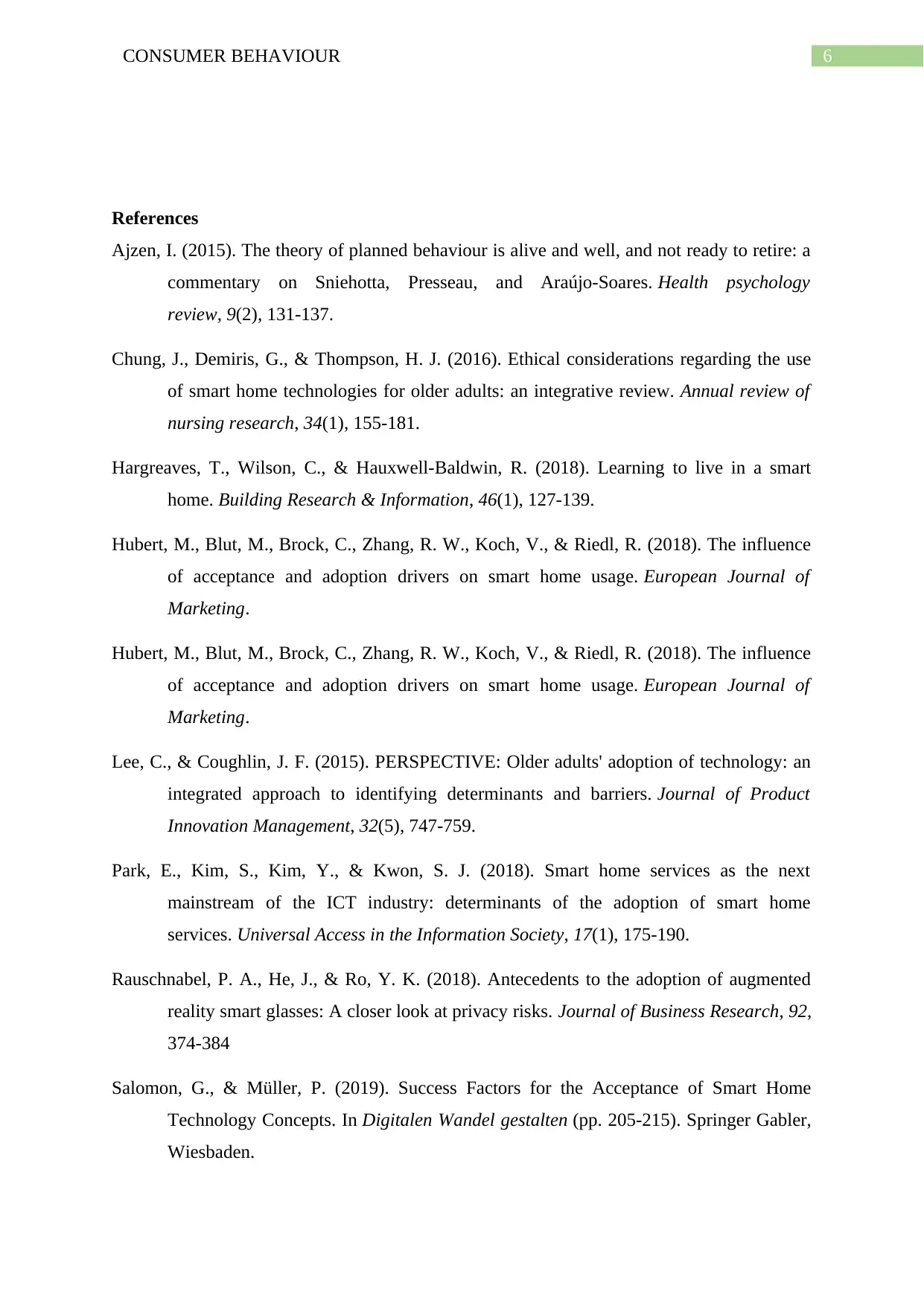
6CONSUMER BEHAVIOUR
References
Ajzen, I. (2015). The theory of planned behaviour is alive and well, and not ready to retire: a
commentary on Sniehotta, Presseau, and Araújo-Soares. Health psychology
review, 9(2), 131-137.
Chung, J., Demiris, G., & Thompson, H. J. (2016). Ethical considerations regarding the use
of smart home technologies for older adults: an integrative review. Annual review of
nursing research, 34(1), 155-181.
Hargreaves, T., Wilson, C., & Hauxwell-Baldwin, R. (2018). Learning to live in a smart
home. Building Research & Information, 46(1), 127-139.
Hubert, M., Blut, M., Brock, C., Zhang, R. W., Koch, V., & Riedl, R. (2018). The influence
of acceptance and adoption drivers on smart home usage. European Journal of
Marketing.
Hubert, M., Blut, M., Brock, C., Zhang, R. W., Koch, V., & Riedl, R. (2018). The influence
of acceptance and adoption drivers on smart home usage. European Journal of
Marketing.
Lee, C., & Coughlin, J. F. (2015). PERSPECTIVE: Older adults' adoption of technology: an
integrated approach to identifying determinants and barriers. Journal of Product
Innovation Management, 32(5), 747-759.
Park, E., Kim, S., Kim, Y., & Kwon, S. J. (2018). Smart home services as the next
mainstream of the ICT industry: determinants of the adoption of smart home
services. Universal Access in the Information Society, 17(1), 175-190.
Rauschnabel, P. A., He, J., & Ro, Y. K. (2018). Antecedents to the adoption of augmented
reality smart glasses: A closer look at privacy risks. Journal of Business Research, 92,
374-384
Salomon, G., & Müller, P. (2019). Success Factors for the Acceptance of Smart Home
Technology Concepts. In Digitalen Wandel gestalten (pp. 205-215). Springer Gabler,
Wiesbaden.
References
Ajzen, I. (2015). The theory of planned behaviour is alive and well, and not ready to retire: a
commentary on Sniehotta, Presseau, and Araújo-Soares. Health psychology
review, 9(2), 131-137.
Chung, J., Demiris, G., & Thompson, H. J. (2016). Ethical considerations regarding the use
of smart home technologies for older adults: an integrative review. Annual review of
nursing research, 34(1), 155-181.
Hargreaves, T., Wilson, C., & Hauxwell-Baldwin, R. (2018). Learning to live in a smart
home. Building Research & Information, 46(1), 127-139.
Hubert, M., Blut, M., Brock, C., Zhang, R. W., Koch, V., & Riedl, R. (2018). The influence
of acceptance and adoption drivers on smart home usage. European Journal of
Marketing.
Hubert, M., Blut, M., Brock, C., Zhang, R. W., Koch, V., & Riedl, R. (2018). The influence
of acceptance and adoption drivers on smart home usage. European Journal of
Marketing.
Lee, C., & Coughlin, J. F. (2015). PERSPECTIVE: Older adults' adoption of technology: an
integrated approach to identifying determinants and barriers. Journal of Product
Innovation Management, 32(5), 747-759.
Park, E., Kim, S., Kim, Y., & Kwon, S. J. (2018). Smart home services as the next
mainstream of the ICT industry: determinants of the adoption of smart home
services. Universal Access in the Information Society, 17(1), 175-190.
Rauschnabel, P. A., He, J., & Ro, Y. K. (2018). Antecedents to the adoption of augmented
reality smart glasses: A closer look at privacy risks. Journal of Business Research, 92,
374-384
Salomon, G., & Müller, P. (2019). Success Factors for the Acceptance of Smart Home
Technology Concepts. In Digitalen Wandel gestalten (pp. 205-215). Springer Gabler,
Wiesbaden.
Paraphrase This Document
Need a fresh take? Get an instant paraphrase of this document with our AI Paraphraser
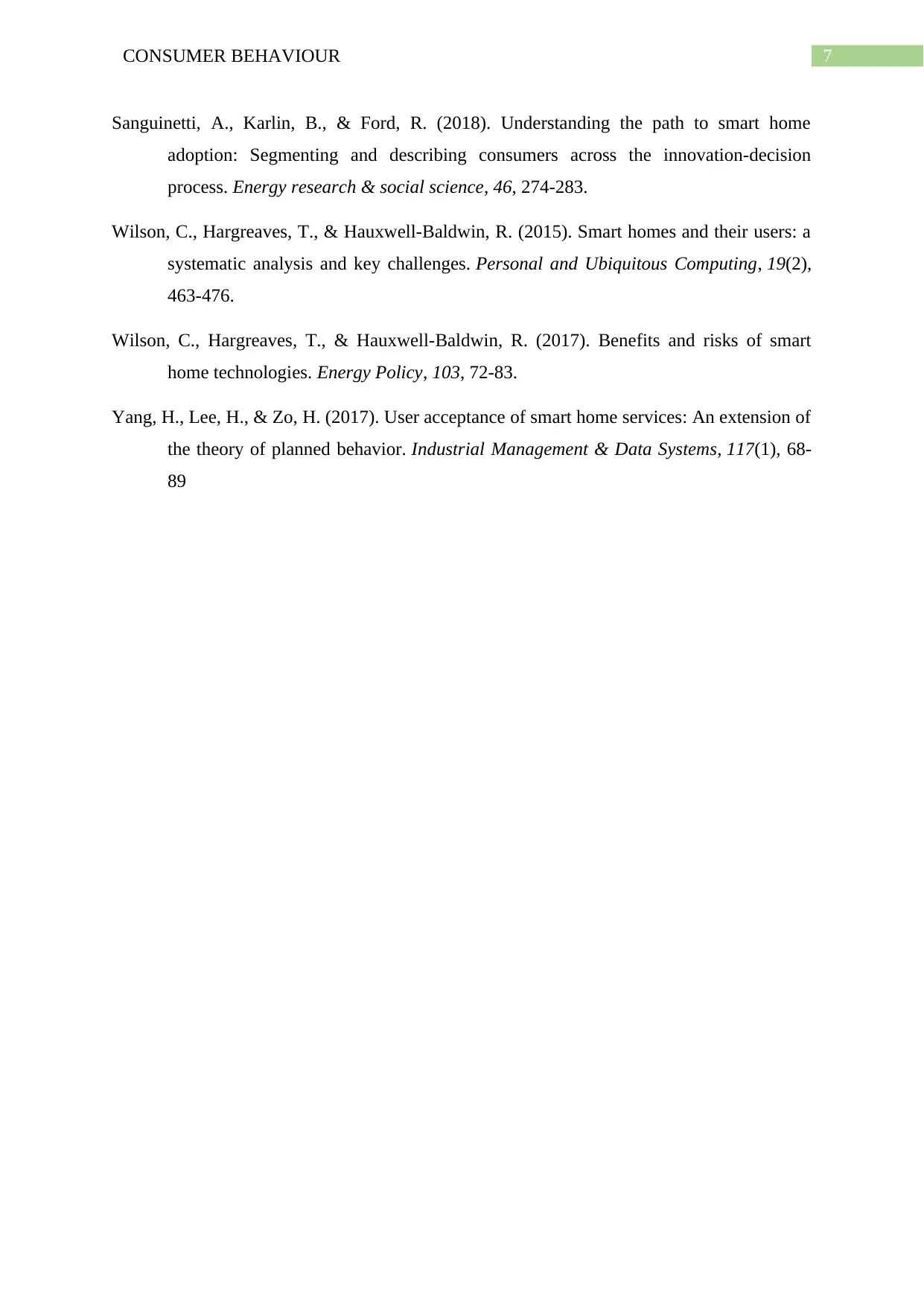
7CONSUMER BEHAVIOUR
Sanguinetti, A., Karlin, B., & Ford, R. (2018). Understanding the path to smart home
adoption: Segmenting and describing consumers across the innovation-decision
process. Energy research & social science, 46, 274-283.
Wilson, C., Hargreaves, T., & Hauxwell-Baldwin, R. (2015). Smart homes and their users: a
systematic analysis and key challenges. Personal and Ubiquitous Computing, 19(2),
463-476.
Wilson, C., Hargreaves, T., & Hauxwell-Baldwin, R. (2017). Benefits and risks of smart
home technologies. Energy Policy, 103, 72-83.
Yang, H., Lee, H., & Zo, H. (2017). User acceptance of smart home services: An extension of
the theory of planned behavior. Industrial Management & Data Systems, 117(1), 68-
89
Sanguinetti, A., Karlin, B., & Ford, R. (2018). Understanding the path to smart home
adoption: Segmenting and describing consumers across the innovation-decision
process. Energy research & social science, 46, 274-283.
Wilson, C., Hargreaves, T., & Hauxwell-Baldwin, R. (2015). Smart homes and their users: a
systematic analysis and key challenges. Personal and Ubiquitous Computing, 19(2),
463-476.
Wilson, C., Hargreaves, T., & Hauxwell-Baldwin, R. (2017). Benefits and risks of smart
home technologies. Energy Policy, 103, 72-83.
Yang, H., Lee, H., & Zo, H. (2017). User acceptance of smart home services: An extension of
the theory of planned behavior. Industrial Management & Data Systems, 117(1), 68-
89
1 out of 8
Related Documents
Your All-in-One AI-Powered Toolkit for Academic Success.
+13062052269
info@desklib.com
Available 24*7 on WhatsApp / Email
![[object Object]](/_next/static/media/star-bottom.7253800d.svg)
Unlock your academic potential
Copyright © 2020–2025 A2Z Services. All Rights Reserved. Developed and managed by ZUCOL.





